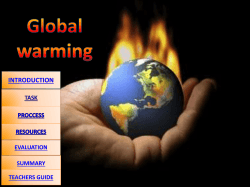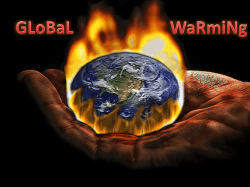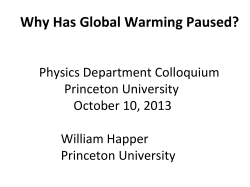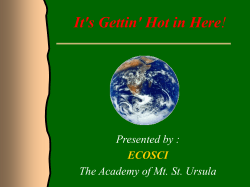
Prime Meridian
Prime Meridian (32) October 30, 2014 A newsletter following global environmental issues alongside the cycle of the seasons in Southern England Above: Sunrise over the South Pacific as seen from aboard the International Space Station May 5, 2013. Expedition 35. Missing the 2 C target. o We shall very probably cross the nominal threshold for a “dangerous” rise in global mean temperature. There have been a succession of climate summits and assurances from politicians about curtailing CO2 emissions in order to keep the rise in global temperature below 2oC, which has been quoted widely as the threshold for dangerous climate change. In fact, CO2 emissions have continued to rise at an average of 2.5 % per decade. Some facts and figures about CO2 emissions in 2013. According to estimates released by the Global Carbon Project (report online), the burning of fossil fuels and the production of cement resulted last year in the emission into the atmosphere of some 9.9 ± 0.5 x 10 9 tonnes of carbon bound up in the greenhouse gas carbon dioxide (~ 36 billion tonnes CO2). This represented an increase in CO2 emissions of 2.3%. This was no less than 161% of the emissions in 1990, which is used as a reference year because it was the year of the Kyoto Protocol. During 2013, the contribution to the global output of CO 2 by major countries and regions was China 28%, USA 14%, EU 10% and India 7%. Not all the CO 2 that was released stayed in the atmosphere, where it could enhance the greenhouse effect. It was estimated that: “ In 2013, the ocean and land carbon sinks respectively removed 27% and 23% of total CO 2 (fossil fuel and land use change), leaving 50% of emissions into the atmosphere. The ocean sink in 2013 was 2.9 ± 0.5 GtC, slightly above the 2004-2013 average of 2.6 ± 0.5, and the land sink was 2.5 ± 0.9 GtC slightly below the 2004-2013 average of 2.9 ± 0.8.” (GtC = a giga-tonne = 10 = one billion tonnes) 9 The report warned: “Current trajectories of fossil fuel emissions are tracking some of the most carbon intensive emission scenarios used in the Intergovernmental Panel on Climate Change (IPCC). The current trajectory is tracking baseline scenarios in the latest family of IPCC scenarios that takes the planet's average temperature to about 3.2°C to 5.4°C above preindustrial times by 2100.” So far, for all the optimistic talk and political posturing over a period of decades, we have not actually demonstrated an ability to prevent our CO 2 emissions rising, let alone an ability to actually reduce them. It has been understood since the 19 th C that greenhouse gases released by human activity would bring about climate change. Three and a half decades have passed since this message was stressed at the First World Climate Conference, staged by the World Meteorological Organisation (1979; Geneva, Switzerland). However, CO2 production has proved a runaway juggernaut. It has been estimated that between 1870 and 2013, the total emission of carbon from fossil fuels and cement was 390 ± 20 billion tonnes and from changes in land use 145 ± 50 billion tonnes. 155 ± 60 billion tonnes was sequestered on the land and 150 ± 20 billion tonnes was taken up by the ocean, with 225 ± 5 billion tonnes of the C released by human activity remaining in the atmosphere. Since 1958, atmospheric CO2 concentrations have been measured at a station 3.397 km above sea level on the slopes of Mauna Loa (left) on the big island of Hawaii. Mauna Loa is a giant shield volcano. Such volcanoes are named for their gentle dome-shaped profile, created by outpouring of fluid silica-poor alkali basaltic lava flows. 120 km across, it rises to 4.169 km above sea level. The Hawaiian chain of islands is often considered to have been built up as the Pacific plate has moved over a hotspot deep in the Earth's mantle (although there is some debate about this amongst geologists). The Mauna Loa Observatory (MLO), operated by the Earth System Research Laboratory of the National Atmospheric & Oceanic Administration (USA), measures atmospheric constituents capable of causing climate change or depleting the ozone layer and also looks at aerosols and solar radiation parameters. The purpose in establishing the mountain-top observatory was to sample atmospheric gases at a location remote from the main Northern Hemisphere industrial centres. The work was begun by C. David Keeling of the Scripps Institution of Oceanography in March of 1958 at a NOAA facility. Between 1979 to 1995, CO2 accumulated in the atmosphere at a rate of 1.4 parts per million by volume per year, accelerating to 2.0 ppmv between 1995 and 2013. The charts at left are updated to Oct. 2014. The N. Hemisphere's seasonal cycle is superimposed on the long-term increase in CO2. CO2 values peak each year in May (the spring maximum), then decline over the year, as plants take up CO2 during photosynthesis. An autumn minimum occurs in October, at the end of the growing season (when deciduous trees drop their leaves). Then, with decay and respiration dominating, CO2 builds up again over winter and into spring. Top: Aerial view of Mauna Loa. Public domain. J. D. Griggs (USGS). Below: Charts of CO 2 build up as measured at the Mauna Loa Observatory. The apparent futility of the 2oC limit is not a new revelation. It has been the subject of concern in the scientific community for some years. A 2009 paper from Kevin Anderson (Univ. Manchester) and Alice Bows (Univ. Manchester and Univ. East Anglia) illustrates this point. These researchers wrote (p. 41): “There is now little to no chance of maintaining the rise in global mean surface temperature at below 2oC, despite repeated high-level statements to the contrary. Moreover, the impacts associated with 2oC have been revised upwards (e.g. [Smith et al., 2009; Mann, 2009], sufficiently so that 2oC now more appropriately represents the threshold between dangerous and extremely dangerous climate change.” The 2008 report of the UK’s Committee for Climate Change (CCC) had admitted that: “it is not now possible to ensure with high likelihood that a temperature rise of more than 2oC is avoided”. Anderson & Bow reproduced this quote and pointed out (p. 40): “given the view that reductions in emissions in excess of 3– 4% per year are not compatible with economic growth, the CCC are, in effect, conceding that avoiding dangerous (and even extremely dangerous) climate change is no longer compatible with economic prosperity.” There was a disturbing gap between policy and reality. The unfortunate truth (p. 23) was that: “Although the language of many high-level statements on climate change supports unequivocally the importance of not exceeding 2 oC, the accompanying policies or absence of policies demonstrate a pivotal disjuncture between high level aspirations and the policy reality [Stern, 2006]. In part this reflects the continued dominance of ‘end point’ targets [Meinshausen et al., 2009] rather than scientifically credible cumulative emission budgets and their accompanying emission pathways. However, even within nations such as the UK, where the relevant policy community (and recent legislation) align themselves closely with the science of climate change, the disjuncture remains.” Half a decade later, this gap remains as wide as ever. References. Anderson, A. & Bows, A. (2011). Phil. Trans. R. Soc. A 369: 20–44. CCC (2008). Building a low-carbon economy—the UK’s contribution to tackling climate change. Norwich, UK: The Stationery Office. Mann, M. E. (2009). Defining dangerous anthropogenic interference. Proc. Natl Acad. Sci. USA 106: 4065–4066. Meinshausen, M. et al. (2009). Nature 458: 1158– 1162. Smith, J. B. et al. (2009). Proc. Natl Acad. Sci. USA 106: 4133–4137. Stern, N. (2006). Stern review on the economics of climate change. Cambridge, UK: Cambridge University Press. Left: Small wild flowers along the margin of a field of maize near West Kingsdown, Kent; From top: speedwell (Veronica persica), pansy (Viola arvensis), and scarlet pimpernel (Anagallis arvensis). August 31, 2014. October 2014 – a fresh call to re-think the 2oC danger limit. The wisdom of the 2oC threshold was challenged in a timely item published in Nature on October 2, 2014. It came from two researchers at the University of California, San Diego, David G. Victor, of the School of International Relations and Pacific Studies and Charles F. Kennel of the Scripps Institution of Oceanography. They noted (p. 30) the goal of keeping warming under 2oC: “bold and easy to grasp — has been accepted uncritically and has proved influential.” In reality, “dangerous anthropogenic interference in the climate system” (1992 United Nations Framework Convention on Climate Change) would have a different meaning depending on the aspect of the climate system or country being considered. Victor and Kennel did not mince their words: 2 oC is misleadingly precise and has no firm scientific basis, but because it looks like a clearly identified target it has enabled politicians to create an appearance of working towards a meaningful solution. “Pretending that they are chasing this unattainable goal has also allowed governments to ignore the need for massive adaptation to climate change.” Since 1992, (pp. 30-31): “two nasty political problems have emerged. First, the goal is effectively unachievable [Victor, 2011]. Owing to continued failures to mitigate emissions globally, rising emissions are on track to blow through this limit eventually. To be sure, models show that it is just possible to make deep planet-wide cuts in emissions to meet the goal [Clarke, L. et al., 2014]. But those simulations make heroic assumptions — such as almost immediate global cooperation and widespread availability of technologies such as bioenergy carbon capture and storage methods that do not exist even in scale demonstration [Victor et al., 2014].” Victor and Kennel argued that scientists, public and policy makers should not be assessing climate change in terms of just one factor, namely temperature, but must consider at a wide range of indicators of the state of the global environment. The Earth's mean temperature has failed to set new annual records since 1998 – a puzzling hiatus which has attracted much attention from climate scientists – but there have, even so, been significant changes to our global environment. Our planet has continued to take up extra solar energy. The energy trapping effect of greenhouse gases (radiative forcing) continues to increase and the high latitudes are most sensitive. Meanwhile, the oceans have been warming, absorbing 93% of the extra warmth. Another failing of existing stratagems, they insisted, was that too little attention has been paid to programmes of specific actions required for different countries. Right: Looking up through the leaves of an English Oak on September 23, 2014. Belair Park, South London. Left: fallen apples lie beneath a tree on the hill side Rosendale Allotments, South London. October 10, 2014. The fact that surface temperature has not yet exceeded its 1998 peak is sometimes quoted by those arguing against man-made climate change as evidence that supposed global warming has ceased. Studies have confirmed, however, that warming has continued, but that it has been concentrated in the upper part of the oceans. Obtaining a better knowledge of how the oceans are warming is essential in understanding how climate is changing and two recent papers have provided useful insights. Paul Durak of the Lawrence Livermore National Laboratory, California and his coworkers argued in a paper in Nature Climate Change that the extent to which the ocean had warmed in the period 1970 to 2004 had been underestimated. This was down to poor sampling in the Southern Hemisphere and to the conservative estimates of warming emerging from analysis methods produced for datasparse regions. Meanwhile, a study by William Llovel of the Jet Propulsion Laboratory, Pasadena, California and co-workers looked at data from January 2005 to December 2013 and found that warming had been concentrated into the top 2 km of the oceans, with little below this depth. Their abstract reported: “The net warming of the ocean implies an energy imbalance for the Earth of 0.64 0.44Wm-2 from 2005 to 2013.” Thermal expansion of sea water has caused sea level to rise and this explained 0.77 ± 0.28 mmyr-1 of the observed sea level rise (2.78 ± 0.32 mmyr-1 between 2005 to 2013; 3.2 ± 0.4 mmyr-1 for the whole period for which satellite altimetry is available). The sea level rise by 2100 will displace millions. A new analysis by a team of authors headed by S. Jevrejeva of the National Oceanography Centre, Liverpool, UK has investigated the upper limit of sea level rise by 2100 and concluded that there is a 5% chance of it exceeding 180 cm. They acknowledged, however, large uncertainties in our understanding of the processes involved. Long-term rises in sea level around the world are the thermal expansion of water as it becomes warmer, the loss of ice from glaciers, and the ice sheets of Greenland and Antarctica and changes in the way water is stored on land (assuming that ice sheet loss more than doubles as the mean global temperature rises by 2 oC to 4oC; Bamber & Aspinall 2013). Developing a better understanding of these processes is essential because, as noted by Jevrejeva and coworkers, over 600 million people live in coastal areas within 10 m of sea level (McGranahan et al. 2007). With 150 million people occupying areas within a mere 1 m of high tide (Lichter et al. 2011), it is evident that sea level rises during the 21 st Century will require substantial populations to re-locate. References: Bamber, J. L. & Aspinall, W. ( 2013). Nature Climate Change 3: 424–427. Clarke, L. et al. (2014). In Climate Change 2014: Mitigation of Climate Change. Contribution of Working Group III to the Fifth Assessment Report of the Intergovernmental Panel on Climate Change (O. Edenhofer, et al. Eds.). Cambridge, UK: Cambridge Univ. Press. Durak, P, J. et al. (2014). Nature Climate Change PUBLISHED ONLINE: 5 October, OCTOBER 2014 | DOI: 10.1038/NCLIMATE2389. Jevrejeva, S. et al. (2014). Environ. Res. Lett. 9 (2014) 104008 (9pp). Lichter, M,. et al. (2011). J. Coast. Res. 27: 757–768. Llovel, W. et al. (2014). Nature Climate Change PUBLISHED ONLINE: 5 OCTOBER 2014 | DOI: 10.1038/NCLIMATE2387. McGranahan, G,. et al. (2007). Environ. Urban. 19: 17–37.Victor, D. G. (2011). Global Warming Gridlock: Creating More Effective Strategies for Protecting the Planet Cambridge, UK: Cambridge Univ. Press. Victor, D. G. et al. (2014). In Climate Change 2014: Mitigation of Climate Change. Contribution of Working Group III to the Fifth Assessment Report of the Intergovernmental Panel on Climate Change (O. Edenhofer, et al. Eds.). Cambridge, UK: Cambridge Univ. Press. Victor, D. G. & Kennel, C. F. (2014). Nature 541: 30-31. How plants speed up Arctic warming. The way in which life and its environment interact and modify each other adds complexity to the task of predicting what the future holds. Up in the Arctic, where warming has been more pronounced than at lower latitudes, increased plant growth may be accelerating the warming process and so, loss of ice. The possibility was explored by Jee-Hoon Jeong of Chonnam National University, Korea and co-workers in a recent paper published in the journal Environmental Research Letters. CO2, of course, is not only a greenhouse gas, but, together with water, is the raw material for plants to carry out photosynthesis, whereby they make their own foodstuffs, grow and repair themselves. As the amount of CO 2 in the atmosphere rises (this does not necessarily apply for higher plants at very high CO 2 concentrations), plant growth will be stimulated. Plant life adapted to the tough environment of the high latitudes has been encouraged to flourish and spread. “The warming and lengthening of the growing season have led to increased vegetation greenness in the Arctic tundra and in grassland areas and have stimulated the expansion of shrub plants in PanArctic regions for the last several decades” (Bunn et al. 2007, Jeong et al. 2011, Tape et al. 2006, Tucker et al. 2001, Xu et al. 2013, Zhou et al. 2001b). Jeong's group used a simulation to compare plant growth at a CO2 concentration of 355 parts per million by volume and 710 ppmv. Plants offer a surface that is poorly reflective, so as they spread, they absorb more energy from the Sun and this enhances surface warming. Plants would thus: “induce additional surface warming and turbulent heat fluxes to the atmosphere, which are transported to the Arctic through the atmosphere. This causes additional sea-ice melting and upper-ocean warming during the warm season. As a consequence, the Arctic and high-latitude warming is greatly amplified in the following winter and spring, which further promotes vegetation activities the following year.” References. Bunn et al. (2007). EOS 88: 33-340. Jeong, S.-J. et al. (2011). Glob. Change Biol. 17: 2385-2399. Jeong, J.-H. et al. (2014). Environ. Res. Lett. 9. 094007 (10pp). Tape, K. et al. (2006). Glob. Change Biol. 12: 686-702. Tucker, C. J. et al. (2001). Int. J. Biometeorol. 45: 184-190. Xu, L. et al. (2013). Nature Clim. Change 3: 581-586. Zhou, L. M. et al. (2001b). J. Geophys. Atmos. 106: 20069-200083. Right: Yellowing lime leaves. Belair Park, South London. October 17, 2014. Left: fallen leaves beside a road in South London. October 17, 2014. Editorial: Challenges for policy makers. What does the future hold? According to projections quoted in Tollefson, 2011 (Nature 480: 299-300.) if cuts in emissions managed to reduce the rise in mean global temperature by the year 2100 to 1.5oC above pre-industrial levels, there could be a sea-level rise of ~ 0.65 m, with cereal yields declining in poor, low-latitude countries. A 2oC warming could see a sea-level rise of ~ 0.8 m, with widespread coral bleaching. The consequence of a 3.5 oC warming, predicted for cuts in emissions actually pledged to date, could be a sea-level rise of ~ 1.0 m and die-back in the Amazon rainforest. What can we do? Green feel-good projects, such as recycling, garden-grown food, more efficient water use and renewable energy initiatives are worthy on their own terms, but give us no cause to retreat into a world of wishful thinking and complacency. Even the most determined advocacy for renewable energy (see, for example, George Monbiot's “Heat. How To Stop The Planet From Burning.” Cambridge, MA, USA: South End Press; 2007) recognises that it will not provide the greater part of our energy needs. Meanwhile, as Monbiot warns, sectors such as CO2-emitting aviation are set to expand in response to economic forces. Policy makers must be honest with electorates about the dilemma that we face (namely the economy versus the environment upon which human societies depend), about the likely rise in global mean temperature and associated humanitarian issues. Research into climate and adaptation must be recognised as no less vital to the defence of societies as is the military. Another urgent priority is the development of new and transforming technologies for generating and transmitting energy. Interviewed by Kiran Randhawa for the London Evening Standard (Oct. 20, 2014), physicist Prof. Steven Hawking suggested that potential advances during the next decade included nuclear fusion as the most promising means of producing energy (unlike present nuclear fission reactors it will not produce dangerous radioactive waste). He predicted also high-temperature super-conductors. They would enable much more efficient energy transmission and assist development of magnetic levitation vehicles (which would not have to work against friction from roads or rails). Bold advances may indeed save the day, but they must be pursued as part of a systematic, holistic and flexible plan of action for our stewardship of our world. Above all, we must understand that the world does not owe civilisation a comfortable existence any more than it did to extinct life forms whose remains, prised by fossil hunters from rocks, are on show in museums. We are going to have to earn right to thrive and prosper long-term on planet Earth. our the the the Prime Meridian is published as part the outreach programme of the Ecospheres Project's Earth Campaign. Email: prime-meridian01@hotmail.com Website: http://www.ecospheresproject.wordpress.com/ This newsletter may be copied and distributed freely by any organisation engaged in raising awareness of environmental issues or for general educational purposes. Images in Prime Meridian are from M.J. Heath (unless otherwise specified). Editor M. J. Heath. Editorial assistance, Penelope Stanford. © M. J. Heath, 2014.
© Copyright 2025





















